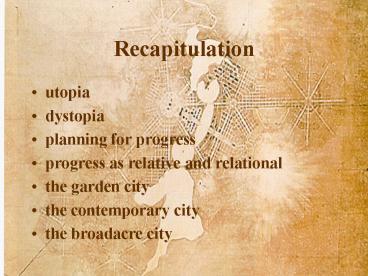Recapitulation - PowerPoint PPT Presentation
1 / 16
Title:
Recapitulation
Description:
Tomorrow - a Peaceful Path to Real Reform (1898) ... Garden Cities of Tomorrow (1902) ... on cit industrielle: formal classicism and functionality of the machine age ... – PowerPoint PPT presentation
Number of Views:918
Avg rating:3.0/5.0
Title: Recapitulation
1
Recapitulation
- utopia
- dystopia
- planning for progress
- progress as relative and relational
- the garden city
- the contemporary city
- the broadacre city
2
The Garden City Movement
- Ebenezer Howard (1850-1928)
- Tomorrow - a Peaceful Path to Real Reform (1898)
Garden Cities of Tomorrow (1902) - Push-pull factors in urban development
- town magnet
- country magnet
- town-and-country magnet
3
1000 acre centrally located citygrand central
park and civic core5000 acres of permanent
agriculture and parklandnew towns connected by
rail
- The garden city
4
Letchworth and Welwyn-Garden Cities Built
5
The contemporary city
- Roots in the works of
- Tony Garnier, French architect, 1917 treatise on
cité industrielle formal classicism and
functionality of the machine age - Futurists - Filippo Marinetti and Antonio
SantElia, 1914, La Citta Nuova - Bauhaus School, Walter Gropius, Weimar, 1919, the
avante garde
6
The contemporary city
- Charles-Edouard Jeanneret - Le Corbusier
- (1887-1969)
- Modernist of the International Style
- The City of Tomorrow and its Planning (1929)
- 3 million inhabitants
- several hundred acres of Paris to be demolished
7
The contemporary city
- Le Corbusiers basic formula both architecture
and cities should be machines for living - key to reduce the congestion of city centres by
increasing their density by building up - high
density, high-rise city cores leaving land for
green space and private transport - class segregation elite to have spacious and
best appointed tower blocks workers to have
small garden apartments in satellite units some
distance from the centre (Brasilia)
8
The contemporary city
- Plan Voisin
- eighteen 700-foot towers to be built on the
historic north side of the River Seine - uniform cells/apartments, standardized furniture
- La Ville Radieuse (1933) - giant collective
apartment blocks - The heroic scale of his ideas and his sheer
irrepressibility drew admiration from architects
and urban designers who wanted leadership and
recognition, while his willingness to confront
the automobile era drew admiration from
technocrats. From this admiration grew a
conventional wisdom that was centred on the need
to modernize cities through ruthless
redevelopment, tearing out their centres and
replacing them with high-rise housing linked by
intrusive freeways (Knox 1995, 158).
9
The contemporary city
- LUnité dHabitation, Marseilles, 1950s
- integrated community services
- daycare facilities
- shops
- poured concrete sections and panels, textured and
sculpted with recessed windows and balconies - inexpensive and amenable to prefabrication the
grid
10
Demolition of the Pruitt-Igoe Project, St Louis
11
The broadacre city
- Frank Lloyd Wright
- individualism, naturalism
- response to automobility (Mumford noted that
automobiles were antithetical to the very idea of
the city) - premised on assumption of three inalienable
rights - social right to direct medium of exchange -
social credit - social right to place on the ground to be held
only by use and improvement - social right to the ideas by which and for which
we live public ownership of invention and science
12
The broadacre city
- planned metropolitan decentralization using the
vehicle to enhance opportunities for individual
lifestyles and closeness to nature - decreased densities and more land per occupant
- differentiated and individualized homes
- based on use of high-pressure concrete, plywood
and plastic for housing, surrounded by networks
of landscaped parkways and freeways - these semi-rural neighbourhoods were to be
serviced by massive public service stations
providing a range of low-order goods and services
13
- Here now may be seen the elemental units of our
social structure the correlated farm, the
factory-its smoke and gases eliminated by burning
coal at places of origin, the decentralized
school, the various conditions of residence, the
home offices, safe traffic, simplified
government. All common interests take place in a
simple coordination wherein all are employed
little farms, little homes for industry, little
factories, little schools, a little university
going to the people mostly by way of their
interest in the ground, little laboratories ...
(Wright 1935, in The City Reader).
14
Radburn
- Clarence Stein and Henry Wright
- 15 miles from Manhattan in Fair Lawn, New Jersey,
1928 - based on Sunnyside superblock (Sunnyside, Queens,
1924-28) - traffic channeled through road hierarchies,
residential areas virtually traffic free, cycle
and pedestrian paths - housing clustered around irregular shaped open
spaces
15
Radburn
16
Summary
- Utopia - progress - planning
- Relative and relational project that is context
dependent (viz. space, place, time and culture or
society) - Utopian pursuits in city (residential)
development - Howards garden city
- Le Corbusiers contemporary city
- Wrights broadacre city
- Radburn































